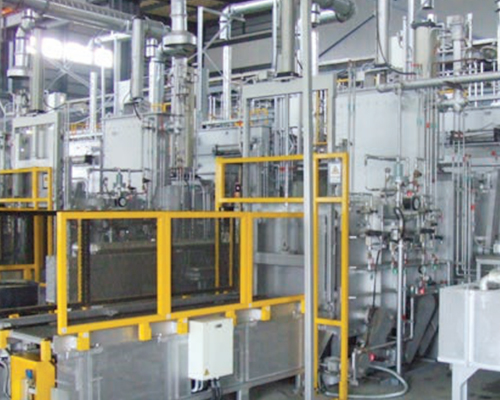Carburizing can only change the chemical composition of the surface of the part. In order to make the part hard and tough on the outside, it must be quenched and tempered at a low temperature after the carburizing heat treatment to improve the strength and toughness of the steel and stabilize the size of the part. According to the composition, shape and mechanical properties of the workpiece, the following heat treatment methods are often used after carburizing.
1) Direct quenching + low temperature tempering
The part is taken out of the heat treatment furnace and directly quenched, then tempered to obtain the desired hardness of the surface. There are two conditions for direct quenching: after the carburizing heat treatment, the austenite grain size is above grade 5-6; there are no obvious reticulated and massive carbides in the carburized layer. 20CrMnTi and other steels are mostly directly quenched after carburizing.
2) Pre-cooling direct quenching + low temperature tempering
The purpose of pre-cooling is to reduce the deformation of the parts, so that the retained austenite on the surface is reduced due to the precipitation of carbides. The surface hardness of pre-cooling and direct quenching is slightly increased, but the grain size does not change. The pre-cooling temperature should be higher than Ar3 to prevent the precipitation of ferrite in the core. If the temperature is too high, it will affect the precipitation of carbides and the amount of retained austenite during the pre-cooling process. increase, but also increase the quenching deformation.
3) One heating quenching + low temperature tempering
The carburized parts are quickly cooled to room temperature and then reheated for quenching and low-temperature tempering, which is suitable for parts with higher strength and better toughness requirements for the core after quenching.

4) High temperature tempering + quenching + low temperature tempering
After high temperature tempering, the residual austenite is decomposed, and the carbon and alloy elements in the infiltration layer are precipitated in the form of carbides, which is easy to machine and reduces the residual austenite. It is mainly used for Cr-Ni alloy steel parts.
5) Secondary quenching + low temperature tempering
After cooling the workpiece to room temperature, it is quenched twice and then tempered at low temperature. Continuous carburizing furnace This is a heat treatment method that ensures high performance of both the core and the surface at the same time. Two quenchings are beneficial to reduce the amount of retained austenite on the surface.
6) Secondary quenching + cold treatment + low temperature tempering
Also known as heat treatment of high alloy steel to reduce the amount of retained austenite on the surface, it is mostly used for gear and shaft parts.


Manufacturing Department:suyj@dowa.com.cn
Processing Department:wucw@dowa.com.cn
URL:www.dowafurnace.com
Address: No. 298, Jiguang South Road, Shipu, Qiandeng Town, Kunshan City


Website